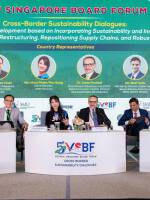
A meeting on June 11 brought together Vietnamese authorities and international partners to shape a roadmap for these centres, drawing lessons from global experience and aligning with Vietnam’s Power Development Plan VIII (PDP8). The meeting, hosted at the Ministry of Industry and Trade and co-chaired by the Electricity Authority of Vietnam (EAV) and Germany’s GIZ Development Agency, was convened under a working on renewable energy centres.
According to a GIZ-led study presented at the session, Vietnam holds technical OSW potential of 600GW, the highest in ASEAN. PDP8 targets up to 17GW of OSW by 2035, rising to 139GW by 2050, with an additional 240GW projected for green hydrogen production. Leveraging this potential through industrial and service hubs could deliver long-term value creation, high-quality jobs, and export advantages for the country’s manufacturing base.
Santiago Alonso Rodriguez, head of German Development Cooperation at the German Embassy in Hanoi, emphasised the significance of conceptual clarity. “Vietnam has the fundamentals to become a leader in energy transition, but renewable energy (RE) hubs must be designed as ecosystems, not just infrastructure,” he noted. “We are not simply talking about power generation; we are looking at systems that integrate industry, education, logistics, and policy to create long-term national value.”
The study positions RE hubs as integrated clusters that combine power generation, manufacturing, training, and infrastructure. Vietnam’s revised PDP8 sets a target of up to 17GW of OSW by 2035, rising to 139GW by 2050, and a further 240GW for green hydrogen. These ambitions align with Vietnam’s broader industrial transformation agenda and climate commitments.
The report recommends prioritising hubs around port areas, leveraging Vietnam’s oil and gas legacy infrastructure, and clustering original equipment manufacturers and tier 1 suppliers in core regions such as Haiphong, Quang Ninh, Ba Ria-Vung Tau, and Binh Thuan. Tier 2 and 3 suppliers, meanwhile, are expected to develop organically across wider regions, creating flexible value chains with high localisation potential.

Philipp Munzinger, director of GIZ’s Energy Support Programme, stressed the need for realism and strategic focus. “Vietnam cannot do everything at once. The key is to build on available strengths, like port infrastructure, industrial zones, and government support, and use them to target viable segments of the OSW chain,” he said.
Drawing from case studies in Denmark, Germany, the United Kingdom, South Korea, and Australia, the study underlines that successful hubs are rarely centralised. Instead, they grow as regional ecosystems anchored by manufacturing and reinforced by tailored training programmes, grid access, and policy incentives.
The report distinguishes between three interlocking types of RE hubs: manufacturing hubs built around ports and logistics; electricity generation hubs to relieve grid congestion and supply green power for industry; and training hubs in cooperation with universities and vocational institutions.
It proposes that electricity generation hubs be prioritised in northern Vietnam to alleviate short-term supply shortages and unlock investment in renewable energy development zones. For green manufacturing aligned with carbon border regulations, the study calls for offshore grid planning, direct power purchase agreements, and certificate trading frameworks.
From a policy perspective, the study urges the use of special economic zones, long-term procurement targets, local content incentives, and infrastructure upgrades to attract investment. It also recommends mapping tier suppliers and assessing synergies across RE technologies such as solar, onshore wind, and green hydrogen. Manufacturing of different technologies does not need to be co-located, but coordination can improve efficiency and pull in diverse capital.
Tang The Hung, deputy director general of the EAV, welcomed the study as a crucial first step. “This is the foundation for our next phase of planning. The findings will be refined and submitted to the government. We also aim to gather further input from stakeholders to ensure the roadmap reflects both technical realities and investment conditions,” he said.
Hung noted that the EAV Authority will work closely with GIZ to expand consultations and build consensus around policy tools and hub development priorities.
The working group will continue to guide this process. Follow-up studies are planned to evaluate industrial policy requirements in greater depth and to define specific actions on workforce development, value chain mapping, and OSW integration. With technical potential of 600GW in OSW, Vietnam stands well-positioned to scale a future-facing industrial ecosystem, one that not only meets clean energy goals, but also anchors a competitive role in global supply chains.
Nguyen Thu




